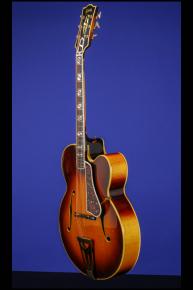"The Art Of The Fine Guitar"
1956 Gibson Super 400C Premier.
This absolutely amazing 18-inch-wide, 3 3/8-inch deep acoustic archtop weighs just 6.10 lbs. Two-piece book-matched close-grained carved spruce top with parallel bracing. Two-piece book-matched birds-eye maple back and flamed maple sides. Two-piece, medium-thick profile flamed maple neck with mahogany center strip, a comfortable nut width of 1 11/16 inches and a scale length of 25 1/2 inches. Ebony fretboard (with pointed end) with 20 original jumbo frets and inlaid pearl single and double split-block position markers. Nine-ply binding on the top, five-ply binding on the back, triple-bound f-holes, triple-bound fretboard (plus a double white line), and five-ply binding on the headstock. Black-faced headstock with five-ply binding and inlaid pearl "Gibson" horizontal script-logo with pearl five-piece split-diamond inlay. Three-piece pearl split-diamond inlay on 'black-faced' back of headstock. Individual Grover Imperial tuners with 'stairstep' gold-plated brass buttons. Non-engraved triple-layer ivory heel plate. Later Super 400 ebony bridge on ebony base with two bow-tie pearl inlays on the ends. Original Gibson brass "Y" shaped tailpiece with model name "Super 400" on cross-bar (Varitone tension device removed). Inside the bass 'f' hole is the Gibson orange oval label with Style: "S-400-C" written in black ink and stamped in black and the serial number "A 24668" stamped in black. The FON number "V 4383 4" is stamped in black inside the treble 'f' hole. All hardware gold-plated. This guitar is in exceptionally fine (9.00) condition, with just a couple of very small surface marks on the top. There is some fine finish checking and two tiny additional holes on the treble side of the neck where a floating pickup had been installed at some time. There is a small 'plug' on the side of the body where the pickguard bracket attaches - this is hidden by the bracket. There is a small 2" scratch on the bass-side of the body near the tail-pin. and some surface wera to the treble side of the neck especially behind the 1st to 3rd and the 7th to 10th frets. Two small areas of surface loss behind the 12th fret and on the heel. The back of the guitar displays a wonderful birds-eye mottled effect. The body sides and back of the neck are also beautifully flamed. Housed in the original Gibson brown hardshell case with burgundy plush lining (8.75) and the original Gibson brown canvas case-cover.
"The Super 400 guitar of late 1934 was designed to be the centerpiece of Guy Hart's strategy to dominate the archtop guitar market. Gibson, a company that had been focused on building toys for the past three years, could not have made a bolder, more assertive return to guitar production than the Super 400 -- the biggest, fanciest, and most expensive guitar available during economic times that were perilous at best. The Super 400 would ultimately achieve many more things than Gibson may have perhaps originally intended. It was so far 'over the top' in terms of size and ornamentation that it caught the immediate attention of musicians, instrument makers, and the general public. The Super 400 certainly caught Gibson's competitors by surprise...The Super 400 was the first guitar of its kind, the first of the 18-inch archtops, and its prominence rests in part on that distinction. The Super 400 also set a new standard of excellence in guitar making...By deliberately picking the choicest materials, utilizing the finest craftsmanship, and sparing almost no expense in construction, Gibson continued to claim the highest standards in the fretted instrument world...The Super 400 quickly became the symbol of all things Gibson, evoking immediate reactions of awe and desire from all those who viewed and played the instrument. It also made synonymous the notions of almost excessive period decor, quality, and value. And finally, it brought a new acoustic voice to the jazz or popular orchestras of the day, as well as to the emerging field of country & Western music and various areas of radio and recording music" (Thomas A. Van Hoose, "The Super 400," in Walter Carter's Gibson Guitars: 100 Years of an American Icon, pp. 146-147).












